
Nicole McCormick Santiago
Nap Time No. 2, oil on canvas, 48 x 63 in.
click here for a larger view
Many thanks to
Nicole McCormick Santiago, a terrific young painter who was gracious to agree to an email interview. I was intrigued by her paintings when I first saw them posted here in the Painting Perceptions forum and was interested to find out more about her.
From her website: “Nicole McCormick Santiago received her BFA in Studio Art from Indiana University in 1999 and her MFA in Painting from the University of New Hampshire in 2003. She has since taught at several institutions including; University of New Hampshire, Edinboro University of Pennsylvania, New Hampshire Institute of Art, Oregon State University, and Berea College. She currently holds the position of Assistant Professor at the College of William & Mary where she teaches Drawing and Color Theory. Her work has been featured in such publications as the Artist’s Magazine and the International Painting Annual 1 (INPA-1). Nicole has shown in over 70 group, juried, and solo exhibitions. She is currently represented by First Street Gallery in New York.
Larry Groff: Your paintings seem to combine observed situations with fleeting moments such as the not-so-still dogs and children. Please tell us about your process in making your paintings. Do you set up a still life in these interior scenes? How much do you work out the composition before hand?
Nicole McCormick Santiago:
Although I prefer to work from direct observation and create the vast majority of my work this way, I also work from memory and photographic references when necessary. This hybrid approach allows me to explore certain ideas and particular types of narrative that are not easily accessible from direct observation alone. For example, in the image Lost, I combine the use of memory, direct observation, and photo references. The figures on the left side of this painting were painted solely from observation. The space and silhouetted figures were painted primarily from memory, while the dogs, right hand figures, and central figure were constructed with a combination of direct observation and photo references. This multiple-process approach removes some of the limitations that come with direct observation alone and allows for more invention within my narrative images. In contrast the images Ghost and Interior were painted directly from life. Basically I use whatever I need to make an image work.
I work out most of my compositions directly on the canvas. However there are times when it seems more productive to use other methods. For instance, thumbnail sketches provide a quick and easy way to move compositional elements around. Another strategy I use for composing is collage. To do this, I photograph the painting in progress and make several small copies. I then cut and paste elements until I’ve reached a composition that is pleasing to me. I also paint and draw on the small copies, making big compositional decisions in a short amount of time.
Domestic spaces provide the type of visual information needed for me to construct the complex layered narratives that I desire. These spaces give me the opportunity to address the domestic condition and to give insight into the social and familial roles of the figure. In 2002, I began to focus almost exclusively on the domestic interior. Having a small studio and limited props, I painted in the readily available household interiors of family and friends. I found that the more disordered the space, the easier it was to relay the cadence of everyday life. This sense of disorder and chaos provided a kind of structure for my images and still resides in my work today. As time went on, I was able to acquire a larger studio, which allowed me to set up faux interiors. This changed my working process, as I was able to have complete control over the space, work for a longer period of time on a single interior, and increase the scale of the images. I have stopped working in true interiors and solely work from set-ups in my studio.

Lost, oil on panel, 12 x 58 in.
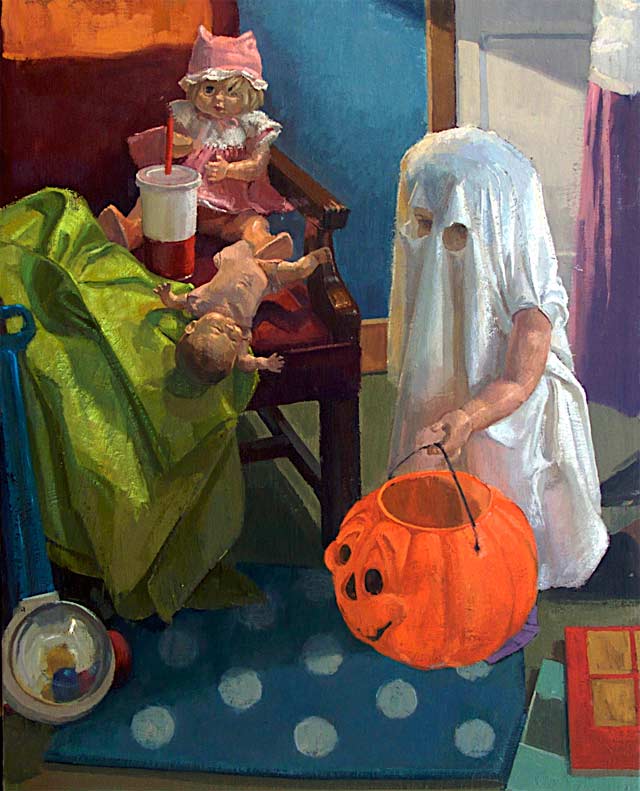
Ghost, oil on canvas, 30 x 24 in.
LG: Your use of vibrant color and the lively paint handling make these paintings seem as fun to look at as it must have been to paint. What gets you the most excited about your painting?
NMS: It’s funny that you refer to my paintings as vibrant. While in school, my paintings were often criticized for being too tonal and lacking color. I’ve worked hard to rid myself this weakness, but I’m always self-conscious about producing gray paintings. I might over compensate a bit. Reading Johannes Itten’s writings on color and learning how to mix pigments more chromatically definitely shifted the color in my paintings. I really enjoy pushing the saturation in my works and often find vermillion a particularly exciting color. I probably over use it.
LG: Story telling, especially those related to scenes of family life, seem an important concern in many of your paintings. How much do you think about the narrative while painting and how much does it influence your more formal painting considerations? Are you trying to convey a message?
NMS: The thing that gets me most excited about my works is the narrative element. Narrative definitely drives my work. I attempt to describe people and places as human situations that carry implied narratives, which stretch out beyond the moment shown. My intention is to give insight into the specific lives of my figures, while also describing the more general human condition. Mostly, the situations I depict are quiet and domestic, which usually makes for still compositions and stories that are more internal than external. I want to defy the stillness of the painting, to portray a layered narrative where the residues of the past and suggestions of the future swirl around the present, creating a kind of “thick time.” To accomplish this, I use the scattered signs of daily existence to communicate accidental yet honest storylines that provide indirect insight into the cadence of a daily life. But that sense of cadence also depends on the formal structure of the picture itself, in the effects of color, light, space, and composition. I never let the narrative lead while making a painting. The painting must first function at a formal level. If I must sacrifice the narrative to make a better the painting, then so be it. Another narrative will eventually present itself during the painting process.
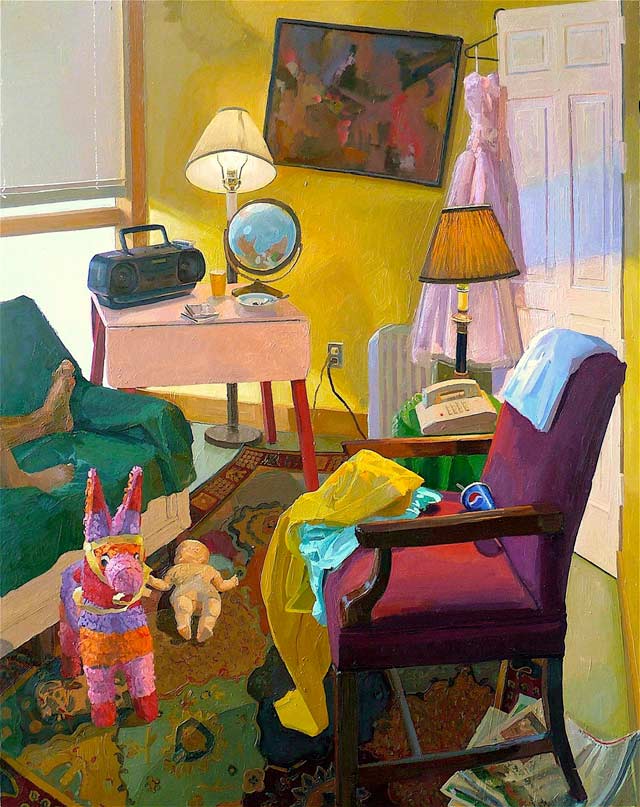
Interior, oil on canvas, 78 x 63 in.??

Blue Room, oil on canvas, 30 x 24 in.?
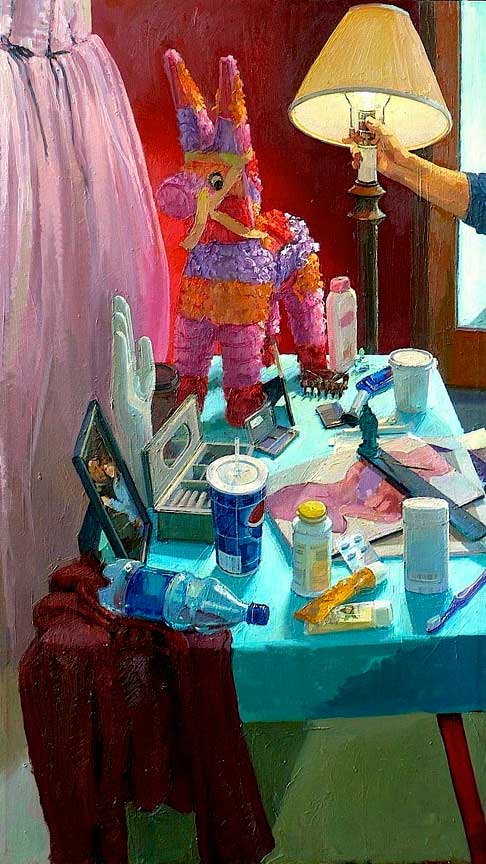
Still-Life with Piñata, oil on canvas, 62.5 x 37 in.??
LG: Who are some of your favorite narrative figurative painters working today?
NMS: There are so many artists that I look to for inspiration, but Paul Rego is definitely one of my favorites. I love her invention, her unusual narratives, and the struggle that is apparent in her works. She is a very brave painter, whose work is both honest and direct. I often look at her work when I having difficulty in my own work
Bob Barnes and Nancy Morgan Barnes have definitely had played a large role in my development as a painter. I studied with them at Indiana University in the ‘90’s. They are brilliant narrative figure painters who greatly influenced my development as a painter.
Some other contemporary narrative figure painters whom I admire include: Jerome Witkin, Dana Schutz, Lee Price, Eve Mansdorf, James McGarrell, Susan Lichtman, Scott Noel, Anne Harris, Gabriel Laderman, and Haley Hassle.
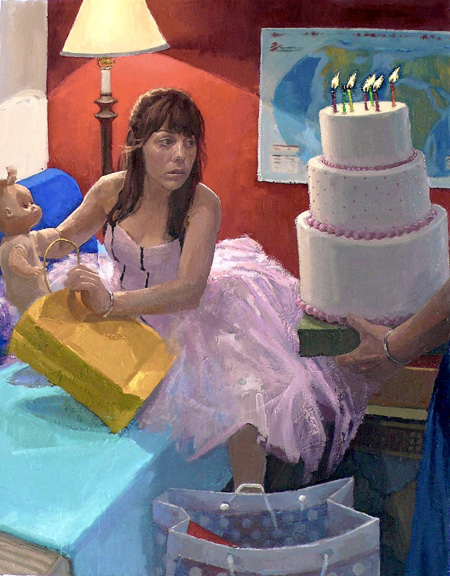
Birthday Scene, oil on linen, 30 x 24 in.

Indulgence I, oil on canvas
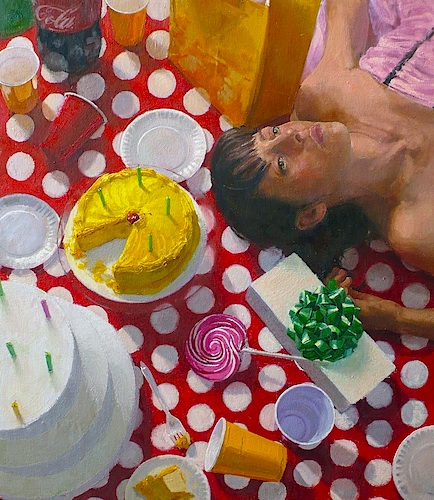
Indulgence II, oil on canvas
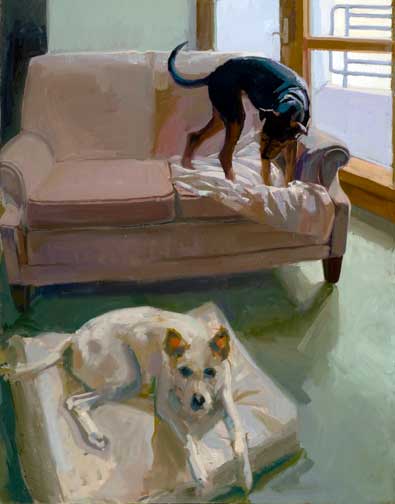
Guilt & Innocence, oil on canvas, 48 x 37 in
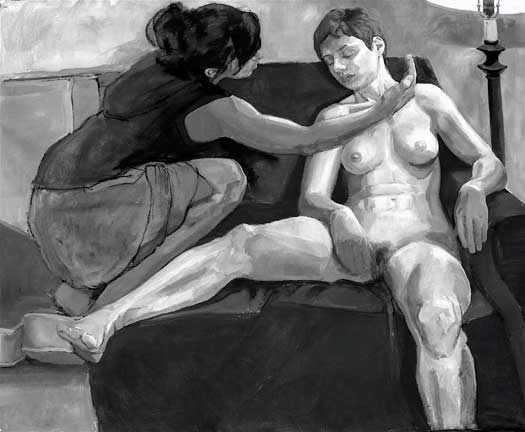
Quickening, charcoal & gesso on canvas, 55 x 46 in.

Neferteri’s Fan, charcoal, conté & gesso on grey paper, 27 x 35 in.





Nicole, I love your compositions and subject matter. Beautiful work.
These works are fantastic!
I love that you put the figure into your still lives and interiors. It’s so difficult to do this without
tipping the balance toward the narrative and ending up with what appears to be an illustration. You’ve succeeded in challenging us to think also about the paint and the design. I’m so glad to see your work here.
Those Birthday party ones are great…I like the vantage point from above and the repetition of the circles. You’ve created an interesting tension between the subject matter and the underlying narrative (mournfulness during a festive occasion?) good work!
Could that first one have any more “content”? The indifferent woman, the crying baby, the looming silhouette of the man, the snoozing dog, all scrunched into that tiny pictorial space…but then I think stories belong in books and paintings are made out of paint, so this kind of narrative art isn’t going to ring my bell anyway.
So many painters out of Indiana University end up with a super-saturated rainbow palette. Intense reds, often. Why is that? The legacy of James McGarrell, I guess. Like Richard there, I don’t get narrative painting.
I’ve known Nikki a few years now. It’s terrific to see the dedication and development of her work. She’s done some tiny cake paintings (portrait almost) I’d really love to have.
Wow, I love these paintings.
Reading over my comment it seems critical of her work. Not so! I was just curious about what goes on at Indiana to bring about the intense palette. Anyone know?
Keep it up Nikki!
I am always thrilled to see the work that Nicole is producing. Her paintings are composed well and are wonderfully sensitive to color. I applaud Nikki for tackling the process of narrative painting and doing it so well! It takes a brave artist to so eloquently express one’s personal experience of the world and also choreograph an interesting composition and metaphor.
Richard and Rob – my thoughts about narrative in painting reflect what I understand about the history of art. Before there were “books” for stories, there were paintings. Before people could read words, people read images. Narrative has been a part of painting for the entire existence of art. I think painters and artists too often get caught in the trap of rejecting a component of art (color, value, narrative, etc.) to define themselves. Isn’t the rejection of narrative just as much of a story as Nicole is depicting here? It tells others about how you think of yourself and with whom you align yourself as a painter. Nicole does the same – creating a connection between herself and thousands, millions maybe, of artists who have told stories before her. It is amazing that she does so while still tackling the formal issues that other artists deal with as well.